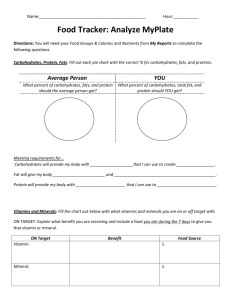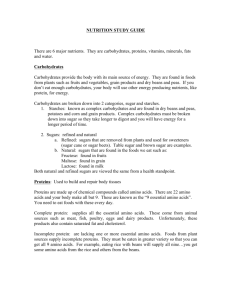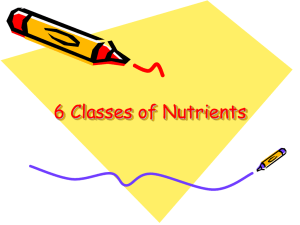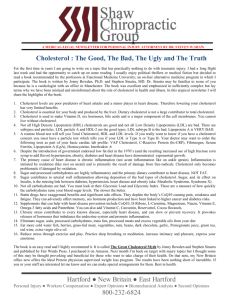General Nutrition Information NUTRIENTS
advertisement
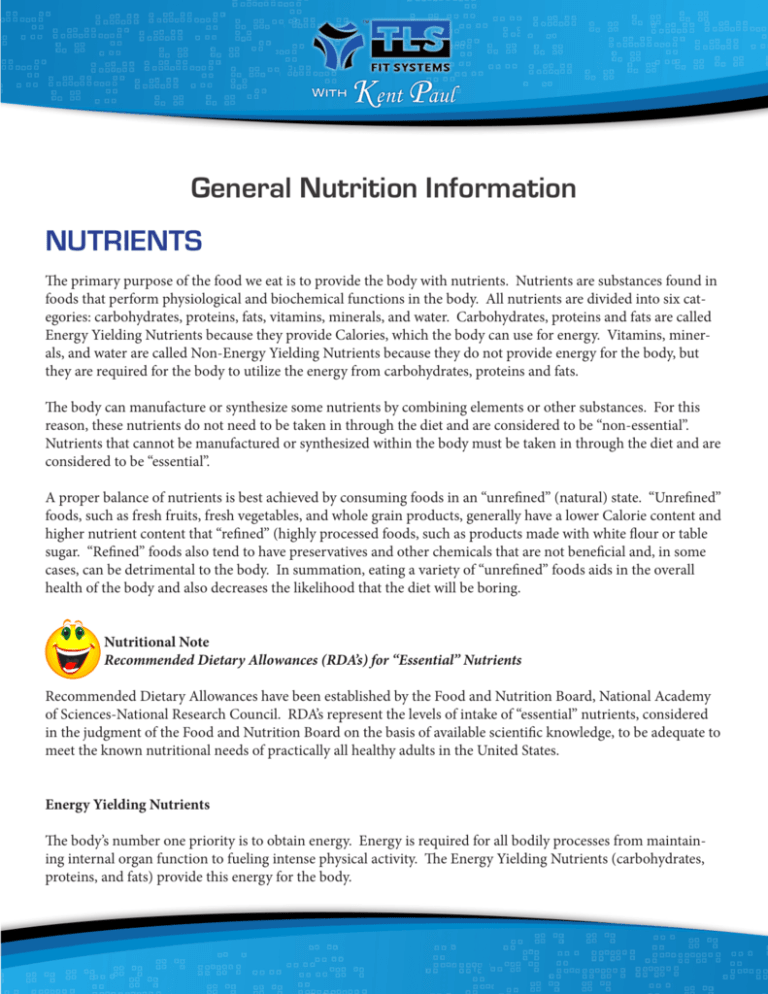
General Nutrition Information NUTRIENTS The primary purpose of the food we eat is to provide the body with nutrients. Nutrients are substances found in foods that perform physiological and biochemical functions in the body. All nutrients are divided into six categories: carbohydrates, proteins, fats, vitamins, minerals, and water. Carbohydrates, proteins and fats are called Energy Yielding Nutrients because they provide Calories, which the body can use for energy. Vitamins, minerals, and water are called Non-Energy Yielding Nutrients because they do not provide energy for the body, but they are required for the body to utilize the energy from carbohydrates, proteins and fats. The body can manufacture or synthesize some nutrients by combining elements or other substances. For this reason, these nutrients do not need to be taken in through the diet and are considered to be “non-essential”. Nutrients that cannot be manufactured or synthesized within the body must be taken in through the diet and are considered to be “essential”. A proper balance of nutrients is best achieved by consuming foods in an “unrefined” (natural) state. “Unrefined” foods, such as fresh fruits, fresh vegetables, and whole grain products, generally have a lower Calorie content and higher nutrient content that “refined” (highly processed foods, such as products made with white flour or table sugar. “Refined” foods also tend to have preservatives and other chemicals that are not beneficial and, in some cases, can be detrimental to the body. In summation, eating a variety of “unrefined” foods aids in the overall health of the body and also decreases the likelihood that the diet will be boring. Nutritional Note Recommended Dietary Allowances (RDA’s) for “Essential” Nutrients Recommended Dietary Allowances have been established by the Food and Nutrition Board, National Academy of Sciences-National Research Council. RDA’s represent the levels of intake of “essential” nutrients, considered in the judgment of the Food and Nutrition Board on the basis of available scientific knowledge, to be adequate to meet the known nutritional needs of practically all healthy adults in the United States. Energy Yielding Nutrients The body’s number one priority is to obtain energy. Energy is required for all bodily processes from maintaining internal organ function to fueling intense physical activity. The Energy Yielding Nutrients (carbohydrates, proteins, and fats) provide this energy for the body. The Energy Yielding Nutrients are composed of elements that are chemically bonded together. When these chemical bonds are broken in the body, the energy stored within the bonds is released. This release of nutritional energy is measured in kilocalories. The kilocalorie is abbreviated as kcal, C, or capitalized as Calories. Throughout this book nutritional energy or kilocalories will be noted as Calories or C. This is also how it appears on most food labels. The following chart illustrates the Caloric contents of carbohydrates, proteins, and fats. Calories produced by Energy Yielding Nutrients 1 gram of carbohydrate………… 4 Calories 1 gram of protein …………........ 4 Calories 1 gram of fat …………………… 9 Calories Nutritional Note Alcohol Calories Alcohol is not a nutrient; however, one gram of alcohol yields 7 Calories. These are “empty” Calories with no significant nutrient value. Alcohol Calories can directly become body fat. [Alcohol discussed in detail on page 18] CARBOHYDRATES [Energy Yielding Nutrient, 4 Calories/gram] Carbohydrates, which are sugars, supply the main source of short-term energy for the body. Dietary carbohydrates come from plant sources and milk products and are classified as simple sugars and complex carbohydrates (starches). Simple Sugars The simple sugar group consists of monosaccharide and disaccharides. Monosaccharide are the simplest forms of sugar, disaccharides are two monosaccharide units chemically combined. All carbohydrates must be ingested as or broken down into monosaccharide units and chemically converted into glucose before the body can utilize them for energy. The 3 monosaccharide are glucose, fructose, and galactose. Glucose, also known as blood sugar, can be directly absorbed and used for energy in the same form that it is ingested. Fructose and galactose usually undergo a chemical change and are converted into glucose before the body uses them for energy. The three disaccharides are maltose, sucrose, and lactose. A disaccharide must be converted into two monosaccharide units before it can be absorbed into the body. One chemical bond must be broken in the conversion process. Disaccharides are as follows: Disaccharide = Monosaccharide + Monosaccharide maltose (grain sugar) = glucose + glucose sucrose (table sugar) = glucose + fructose lactose (milk sugar) = glucose + galactose A person should minimize their consumption of the disaccharides maltose and sucrose because it is possible to take in large amounts of Calories from these disaccharides very quickly. Small amounts of these simple sugars contain high amounts of “empty” Calories, which supply energy but have minimal or no other nutrient content. Forms of maltose and sucrose that should be minimized in the diet (Check product ingredient labels for these simple sugars in disguise!) beet sugar malt sugar brown sugar malt syrup cane sugar maltose cane syrup maple sugar corn syrup maple syrup honey molasses powdered sugar sucrose table sugar white sugar natural sugar Complex Carbohydrates The term complex carbohydrate is synonymous with the term “starch” and “polysaccharide.” Complex carbohydrates consist of three or more glucose units chemically bonded together. They are the most beneficial forms of dietary carbohydrates to consume. Complex carbohydrates have their highest nutrient content when they come from “unrefined” plant sources such as whole grains, fresh fruits, and fresh vegetables. Some examples of Complex Carbohydrates that should be consumed brown rice cereals (no sugar) corn fresh fruits fresh vegetables pasta (plain) popcorn (plain) potatoes (plain) legumes whole grains whole grain breads Some examples of Carbohydrates that should NOT be consumed cakes candy canned fruits (sugar syrup) cookies corn chips donuts honey ice cream jams jellies light beers marshmallows molasses popcorn (oil popped or buttered) potato chips refined carbohydrates regular soda pop sweetened beverages sweetened beverage mixes sweet liquors sweetened pudding sweetened yogurt syrups white flour products Sources of Sweeteners that may be consumed (These sources can be the sweetening ingredients of a product. For example, Diet Coke is sweetened with Nutrasweet.) Acesulfame Dextrin Equal Fructose (fruit sugar) Fructose syrup Malto-dextrin Nutrasweet (aspartame) Soluble saccharin Sugar Twin Sweet-N-Low Splenda Stevia Zsweet Nutritional Note Intestinal Gas or Flatulence Raffinose and stachyose are the two main sugars in beans and legumes; However, these sugars are chemically bonded in such a way that they cannot be broken down by the digestive enzymes in the body. Since they cannot be digested, raffinose and stachyose pass through the large intestine where they are metabolized by bacteria. This causes intestinal gas or flatulence. Beano - Beano is an enzyme preparation that digests raffinose and stachyose, if consumed immediately before a meal. For this reason, Beano reduces intestinal gas. Beano can be purchased in stores. Some other ways to reduce intestinal gas or flatulence are: 1. Eat slowly and chew food well; 2. Relax when eating; 3. Do not chew gum; 4. Do not eat greasy foods; 5. Do not eat, or minimize, the consumption of gassy foods such as beans, broccoli, cabbage, carbonated beverages, cauliflower, chewing gum, corn cucumbers, excessive fiber, onions, and turnips. PROTEINS [Energy Yielding Nutrient, 4 Calories/gram] Proteins are required to support the body growth and maintenance. All proteins are made of amino acids. There are 20 common amino acids found in foods; nine of these are “essential” and must be taken in through the diet. A “complete” protein or “high quality” protein is one which contains all nine “essential” amino acids in sufficient quantities for protein synthesis to take place within the body. Complete proteins usually come from animal sources such as meat, fish, poultry, eggs, and dairy products. “Incomplete” or “low quality” proteins often come from plant sources such as grains, legumes, nuts, and seeds. An “incomplete” protein, by itself, is missing an “essential” amino acid or does not contain sufficient quantities of “essential” amino acids. Because of this, protein synthesis within the body cannot take place; as a result, the amino acids are degraded, converted into fat, and stored as body fat. Plant sources can be made into complete proteins when combinations of any two of the following groups are consumed; Nutritional Note Vegetarians and Protein The reason a vegetarian can get enough protein through the diet is because “incomplete” plant sources of protein can compliment each other to form “complete” proteins in the body. Functions of Proteins: 1. 2. 3. 4. 5. 6. 7. 8. 9. Protein is used for energy Protein builds and supports lean muscle mass Protein is the main component of hair and nails. Protein is necessary for proper immune system functioning Protein is a structural component of skin, muscles, tendons, internal organs, bones, and membranes. Blood clotting proteins assure that a person does not bleed to death from a cut, bloody nose, etc… The body’s digestive enzymes are made of proteins. Blood proteins transport lipids, minerals, and oxygen to specific tissues where they are needed. Protein aids in water and electrolyte balance. Some examples of high quality Protein Sources (The following protein sources should be prepared by baking, boiling, broiling, microwaving, pan frying with non-stick pan spray, poaching, or steaming) Crustaceans crab (fresh) crayfish (fresh) shrimp (fresh) halibut (fresh) orange roughy (fresh) sardines (canned in water) tuna (canned in water) whiting (fresh) Eggs egg whites only mussels (fresh) oysters (fresh) Fish bass (fresh) cod (fresh) haddock (fresh) Dairy Products nonfat cheese nonfat cottage cheese nonfat yogurt skim milk Shellfish clams (fresh) Poultry chicken (white meat without skin) turkey (white meat without skin) FATS [Energy Yielding Nutrient, 9 Calories/gram] Fat is used by the body to insulate, provide energy, store energy, cushion internal organs, and produce sexual hormones. Fat is an essential part of the diet; however, for health reasons, a person’s total dietary fat intake should not be greater than 30% or less than 10% of total Calorie intake. Dietary fats are generally referred to as saturated, polyunsaturated, or monounsaturated. Saturated fats are solid at room temperature. Saturated fats are the worst type of fats to consume because they increase the total cholesterol level in the blood. Examples of Saturated Fats beef fats butter fats cheese cocoa butter coconut oil hydrogenated vegetable oil milk fat palm oil palm kernel oil partially-hydrogenated vegetable oil pork fat Polyunsaturated fats are liquids at room temperature. Polyunsaturated fats are more beneficial to consume because they decrease the total cholesterol level in the blood; however, polyunsaturated fats decrease LDL (bad) as well as HDL (good) cholesterol levels. Monounsaturated fats are the most beneficial fats to consume. They decrease total blood cholesterol and LDL (bad) cholesterol levels while having no effect on HDL (good) cholesterol levels. [Cholesterol discussed in detail on page 14] corn oil cottonseed oil sunflower oil Examples of highly Polyunsaturated Fats safflower oil soybean oil fish oil Examples of highly Monounsaturated Fats avocadospeanuts canola oil peanut oil rapeseed oil olive oil Nutritional Note Trans Fatty Acids Most naturally occurring unsaturated fatty acids occur as “cis” fatty acids. The words “cis” and “trans” describe the typical configuration of hydrogen atoms in an unsaturated fatty acid structure. When fats and oils are hydrogenated by human manipulation, the naturally occurring “cis” configuration is turned into a “trans” configuration. Hydrogenation helps to prevent rancidity and is the reason the naturally occurring oils can remain solid at room temperature. For example, corn oil can be made into solid margarine (partially-hydrogenated corn oil). After hydrogenation, polyunsaturated fatty acids are technically considered to be monounsaturated fatty acids and are listed on food labels as such. The human body, however, does not recognize these “trans” configurations to be monounsaturated but treats them as saturated fatty acids. For this reason “trans” fatty acids have been shown to raise total blood cholesterol levels in a similar manner as saturated fatty acids. In Short, on should try to avoid hydrogenated and partially- hydrogenated vegetable oils. Non-Energy Yielding Nutrients The three classes of Non-Energy Yielding nutrients are: vitamins, minerals, and water. The Non-Energy Yielding nutrients can be compared to the spark plugs in an engine, and the Energy Yielding Nutrients can be compared to the gasoline. The spark plugs must ignite the gasoline in order for the engine to run in the same way that the Non-Energy Yielding nutrients must be present for the body to produce energy from carbohydrates, proteins, and fats. VITAMINS [Non-Energy Yielding Nutrients] Warning – Excessive intake of vitamins can cause serious physiological problems, be toxic, or even cause death. Vitamins are organic substances that are involved in almost every metabolic process in the body. Although only minute amounts of vitamins are required in a person’s daily diet, vitamin deficiencies can lead to major health problems. Vitamins are categorized into two classes: fat soluble and water soluble. The fat soluble vitamins are A, D, E, and K. Fat soluble vitamins can be the most toxic because they are stored in body tissues and, therefore, not readily excreted from the body. The water soluble vitamins are B1, B2, Niacin, B6, B12, Pantothenic Acid, Biotin, Folic Acid, and C. Water soluble vitamins are less toxic partially because water in the body dissolves these vitamins and flushes them out of the body via the kidneys. Water Soluble Vitamins B1 (Thiamine) - Necessary for energy metabolism Stimulates growth B2 (Riboflavin) - Necessary for all Caloric nutrient metabolism Aids in the formation of red blood cells Niacin - Necessary for all Caloric nutrient metabolism Helps maintain the health of skin, tongue, and digestive system B6 (Pyridoxine) - Aids in protein metabolism Aids in formation of antibodies Helps maintain the balance of sodium and phosphorus B12 (Cobalamin) - Necessary for proper formation of blood cells Maintains the health of the nervous system Pantothenic Acid - Participates in the release of energy from Carbohydrates, proteins, and fats Improves the body’s resistance to stress Biotin Necessary for fat and carbohydrate metabolism - Folic Acid (Folacin) - It is the most fragile vitamin Important in the formation of red blood cells Necessary for the growth and division of red blood cells The vitamin which is affected to the greatest extent by alcohol C (Ascorbic Acid) - It is an antioxidant Helps in the healing of wounds, scar tissue, and bone fractures Gives strength to blood vessels Aids in the absorption of iron Fights infections Helps form collagen Fat Soluble Vitamins A - Necessary for growth and repair of body tissues Important to the health of the eyes Helps prevent infections Aids in bone and tooth formation Beta-carotene is the anti-oxidant form D - Necessary for absorption and utilization of calcium and phosphorous Required for bone formation Can be synthesized in the body when one is exposed to sunlight The most toxic of all vitamins if taken in excess E - Functions as an antioxidant by neutralizing free-radicals in the blood K - Aids in the normal function of the body’s blood coagulation capabilities MINERALS [Non-Energy Yielding Nutrients] Warning – Excessive intake of minerals can cause serious physiological cause death. problems, be toxic, or even Minerals in the body are components or activators of several enzymes and hormones. Minerals regulate or maintain such physiological processes as muscle contraction, acid-base balance, water balance, oxygen transport, nerve impulse conduction, blood coagulation, bone structure, and normal heart rhythm. There are approximately 25 minerals that are considered to be “essential” in the human body. The specific roles that some of these minerals play have not yet been determined; however, it is known that these minerals exist to varying degrees and play a role in optimal health and physical performance. Some minerals are electrolytes, electrically charged particles that are distributed throughout the fluid compartments of the body. These electrically charged particles are either positively charged (+) or negatively charged (-). The positively charged electrolytes in the body’s extra cellular fluid are sodium, potassium, calcium, and magnesium. These are electrically balanced by the negatively charged electrolytes, chloride, bicarbonate, and proteins, along with relatively low concentrations of the organic acids, phosphate and sulfate. Electrolyte balance is critical for proper body function. Commonly Known Minerals and Their Roles Calcium (Ca) Needed for strong bones and teeth Assists in normal blood clotting Assists in muscle contraction Assists in nerve transmission Assists in heart function Chloride (Cl) Part of acid-base balance Maintains osmotic pressure Chromium (Cr) Aids in the action of insulin Copper (Cu) Aids in energy metabolism and collagen synthesis Necessary for the body to use iron Cofactor in tyrosinase which makes melanin (skin pigment) Fluoride (F) Combines with calcium and phosphorus in teeth and bones to make them stronger Helps reduce dental cavities and, possibly, the chances of osteoporosis Iodine (I) Necessary component of the thyroid hormone (thyroxin) which regulates basal metabolic rate (BMR) Thyroxin deficiency causes weight gain and goiter Iron (Fe) Necessary for the formation of hemoglobin and myoglobin which are responsible for the transport and storage of blood oxygen Helps in protein metabolism and promotes growth Magnesium (Mg) A component of over 300 physiologically important enzymes Helps regulate protein synthesis Manganese (Mn) Essential for normal brain functions Aids in bone growth Aids in fatty acid and cholesterol synthesis Molybdenum (Mo) Found in dental enamel and bones Commonly Known Minerals and Their Roles (continued) Phosphorus (P) Needed to make ATP Used in acid – base balance Works with calcium to help build bones and teeth Potassium (K) Works to control the activity of the heart muscles Works to control the activity of the nervous system Helps rebuild damaged muscle tissue If blood potassium levels get too high, the heart will stop Selenium (Se) Needed in very small amounts to help preserve tissue elasticity Very toxic Sodium (Na) Helps maintain normal fluid levels in cells and blood Helps maintain the health of nervous, muscular, and lymph systems Too much can cause high blood pressure Zinc (Zn) Aids in the healing process of wounds Aids in male sperm production Aids in protein synthesis Is a component of insulin Too much or not enough can inhibit immune function WATER [Non-Energy Yielding Nutrients] Water is considered to be the body’s most important nutrient. The average male is composed of 60% water, and the average female is composed of 50% water. Within the body, water functions to: 1. 2. 3. 4. 5. 6. 7. Regulate body temperature Maintain turgor pressure of the skin (skin has full look) Cushion organs Provide the base for blood transport of oxygen, nutrients, hormones, and other compounds to and from body cells Lubricates joints Aid body senses such as the inner ear Provide the medium for chemical reactions The average person needs 1 milliliter of water per Calorie or, in general, eight 8-ounce glasses of water per day for proper hydration. Water needs increase as protein intake increases because more water is needed to aid the kidneys in diluting and excreting the waste products of protein metabolism. Two common factors that affect the status of water in the body are alcohol and caffeine consumption. Alcohol interferes with ADH (antidiuretic hormone) which is responsible for maintaining a proper fluid balance. Alcohol and caffeine cause a person to excrete more water than is consumed, resulting in dehydration. When a person experiences a lack of sufficient water intake or dehydration, it can lead to the following physical conditions: 1.Constipation 2. Decreased blood pressure 3. Decreased physical endurance 4. Decreased physical performance 5. Decreased turgor pressure (skin loses its full look) 6. Dry mucous membranes 7. Electrolyte imbalance 8.Fatigue 9. Increased heart rate 10. Increased body temperature 11. Lack of appetite 12. Muscles feel soft to the touch, not hard 13.Nausea Other Nutrition Information CHOLESTEROL The body uses a certain amount of cholesterol to maintain cellular function and to produce such things as bile acids, sex hormones, and vitamin D. Dietary cholesterol is not “essential” because the average person’s liver makes about 1000 mgs of cholesterol per day. This is independent of dietary cholesterol intake. About 40% of dietary cholesterol is absorbed into the body. The body makes cholesterol out of such dietary sources as alcohol, blood sugar, and fats. For this reason, a person’s diet must not only be regulated for dietary cholesterol intake, but also, for dietary sources of cholesterol production. Two types of cholesterol of importance in health are low-density lipoproteins (LDL’s or bad cholesterol) and high-density lipoproteins (HDL’s or good cholesterol). LDL’s (bad cholesterol) – LDL’s are made in the blood and are composed mainly of cholesterol. The LDL’s purpose is to deliver cholesterol to the body cells. When the need for cellular cholesterol is less than the actual circulating level of LDL’s, the LDL level in the blood increases. Circulating LDL’s will then start to stick to the walls of blood vessels. Over a length of time, LDL build up or plaque can cause the blockage of blood vessel(s). The result can be poor blood circulation, a heart attack, or a stroke. HDL’s (good cholesterol) – HDL’s are made in the liver and intestine and are composed mainly of protein. HDL’s are made mostly empty and can be referred to as cholesterol disposal trucks. These empty lipoproteins travel around in the blood and pick up excess cholesterol. The HDL’s then carry this excess cholesterol to the liver to be excreted from the body. The HDL blood level is a combination of two subgroups: HDL2’s and HDL3’s. HDL2’s – HDL2’s are associated with a reduced risk of coronary heart disease. Women and trained athletes have substantially higher levels of HDL2’s; and, consequently, a lesser occurrence of coronary heart disease. A person can maintain or raise HDL2 levels by exercising, losing weight, and avoiding smoking. HDL3’s – HDL3’s do not seem to have any correlation with coronary heart disease. HDL3’s are considered to be neutral. Cholesterol levels are measured in mg/dl (milligrams per 100 milliliters of serum) Good Blood Cholesterol Levels Total Cholesterol ≤ 199 mg/dl LDL Level ≤ 129 mg/dl HDL Level ≥ 40 mg/dl (>60 mg/dl even better) Borderline Risk Levels of Blood Cholesterol Associated With Coronary Heart Disease Total Cholesterol 200-239 mg/dl LDL Level 130-159 mg/dl High Risk Levels of Blood Cholesterol Associated With Coronary Heart Disease Total Cholesterol ≥ 240 mg/dl LDL Level ≥ 160 mg/dl HDL Level ≤ 35 mg/dl Some foods high in Dietary Cholesterol Content cream cheese egg yolks (egg whites have no cholesterol) organ meats (brain, liver, heart, kidneys, gizzards) oysters regular cheese veal To maintain or increase HDL cholesterol levels: 1. Exercise 2. Lose weight to attain a proper body weight 3. Avoid smoking To decrease LDL cholesterol levels: 1. Reduce saturated fat intake 2. Reduce cholesterol intake 3. Exercise 4. Lose weight to attain proper body weight 5. Eat fish on a regular basis 6. Consume no more than 2 or 3 cups of coffee per day 7. Increase intake of soluble fiber FIBER Dietary fiber aids in lowering blood cholesterol levels, lowering the rate of glucose absorption, softening stool, accelerating intestinal transit time, and excreting cancer causing agents. Dietary fiber is broken down into two groups, soluble fiber and insoluble fiber. SOLUBLE FIBER Soluble fiber helps lower blood cholesterol levels in two ways: 1. Soluble fiber binds with bile acids which are made of cholesterol and carries the cholesterol out of the body via the feces. The liver must then pull more cholesterol from the blood to make more bile acids. This, in turn, lowers the blood cholesterol level. 2. The fermentation of soluble fiber in the large intestine produces, amongst other things, propionic acid. Some of the propionic acid goes back to the liver via the blood and inhibits HMG-CoA re ductase. This is the enzyme in the liver that is necessary for the body to make cholesterol. As long as the propionic acid is present in the liver, cholesterol production is slowed. This, in turn, lowers the blood cholesterol. Good dietary sources of Soluble Fiber All Bran Apples Bananas Black-eyed peas Cauliflower Corn Dried beans and peas Fresh fruits Grains Kidney beans Lentils Oat bran Oat meal Oranges Pears Pinto beans Prunes Rice bran Split peas Sweet peas Sweet potatoes Vegetables Zucchini Insoluble Fiber Insoluble fiber passes through the body undigested because the human digestive enzymes can not break it down. Insoluble fiber aids in increasing transit time. This means that fecal material passes through the system faster resulting in a decreased risk of intestinal complications such as colon cancer and constipation. Good dietary sources of Insoluble Fiber All Bran Blueberries Fiber One Pumpernickel bread Sweet peas Barley Cereals Fresh fruits and vegetables Prunes Total Blackberries Cracklin Bran Grains Raisin Bran Wheat bran Bran Chex Dates Lima beans Shredded Wheat Whole wheat bread ALCOHOL Alcohol provides 7 Calories/gram. These are “empty” Calories that can go directly toward fat production. Alcohol is a toxin, and excessive intake of more than two drinks per day can have many damaging effects on the body. In most cases, one or two drinks of alcohol (as noted in the following chart) over a 24 hour period do not have damaging effects on the body. Alcohol Content of One Drink Alcoholic Beverage Beer Wine Liquor Measure 12 ounces 4 ounces 1.25 ounces Alcohol Content 4-5% 12-14% 40-45% The alcohol contents in the above chart are approximations. Some alcoholic beverages contain more alcohol in one drink than listed above. For example, 100 proof liquor has a 50% alcohol content; and 200 proof liquor has a 100% alcohol content. This would decrease the measure of one drink. The liver can only metabolize one drink (1/3 ounce) of alcohol per hour. If a person chooses to consume alcohol, the consumption must be in moderation. More than two drinks of alcohol per day can be considered excessive and can have the following damaging effects on the body. Alcohol’s Damaging Effects on the Body 1. Decreases gluconeogenesis (the production of blood sugar) 2. Increases glycogenolysis (the destruction of glycogen or short-term energy stores) 3. Decreases protein synthesis 4. Decreases absorption of the vitamins B1, folic acid, and B12 5. Increases excretion of the minerals calcium, magnesium, potassium, and zinc 6. Increases the body’s need for vitamins B1 and B6 7. Destroys liver cells 8. Causes liver disease (fatty liver) 9. Destroys brain cells 10. Destroys pancreas cells 11. Interferes with ADH causing increased fluid excretion 12. Irritates the stomach 13. Suppresses the brain 14. Increases blood lipid levels, increasing the chance of coronary heart disease 15. May cause Fetal Alcohol Syndrome in pregnant women (baby born with birth defects) 16. Increases the risk of certain forms of cancer 17. Causes serious complications with prescription drugs CAFFEINE Caffeine is a stimulant drug found in many food products. Some sources and amounts of caffeine follow: Source Cocoa Coca-Cola Drip coffee Instant coffee Milk chocolate Mountain Dew Pepsi Tea (black) Vivarin Amount 6mgs / 1oz 46 mgs / 12 oz 110 – 150 mgs / 8 oz 40 – 108 mgs / 8 oz 6 mgs / 1 oz 54 mgs / 12 0z 38 mgs / 12 oz 20 – 46 mgs / 8 oz 200 mgs / tablet Positive effects of caffeine (based on approximately 300 mgs of caffeine 1 hour prior to exercise) 1. 2. 3. 4. 5. Increases free fatty acid levels in the blood so muscles can get more energy from fat Spares muscle glycogen Increases muscle contraction by making a person produce more epinephrine (adrenaline) Increases alertness Stimulates the central nervous system (speeds up heart rate) Negative effects of caffeine 1. 2. 3. 4. 5. 6. 7. 8. Raises anxiety Increases blood pressure Increases fluid excretion Increases secretion of stomach acids (may cause gastric distress or hunger) Can cause cardiac arrhythmia’s (irregular heartbeat) Can cause nausea and light-headedness Speeds up the aging process Can cause diarrhea


